MARIANI’S
April 2, 2006
NEWSLETTER
UPDATE: To
go to my web site, in which I will update food
&
travel information and help link readers to other first-rate travel
& food sites, click on: home page
ACCESS TO
ARCHIVE: Readers may now access
an
Archive of all past newsletters--each annotated--dating back to July,
2003, by simply clicking on www.johnmariani.com/archive
.
NEW
FEATURE! You may now subscribe anyone you wish
to this newsletter by
clicking here.
In
This Issue
Istanbul Part One by John Mariani
NEW YORK CORNER : TABLE XII by John Mariani
QUICK BYTES
~~~~~~~~~~~~~~~~~~~~~~~~~~~~~~
Istanbul, Part One
by John Mariani
Indeed, had the Turks built a Colossus across the Bosporus one leg would be in Europe and one in Asia, and, while the two sides of the city share a great deal in common, they are also very different places. Speak to half a dozen Turks, and you soon come to realize that this dichotomy is, as one former university professor told me, "our psychic dilemma." The Turks are also quick to point out that they are mostly Muslims, but they are definitively not Arabs.
Don't for a moment think that Turkey's long delayed entry into the European Union isn't part of this dilemma, which plays into fears of it being engulfed by eastern immigrants who to this day live under the sway of a Muslim government. And the troubling, recent outbreak of bombings in the city are the prolongation of the Asian Kurdish discontents dating back to the 7th century, when the Arabs conquered them and converted them to Islam.
Clearly, the European side of the city towers in influence and affluence over the Asian city, which is a sprawl of crowded streets intersecting as if to little purpose except to lead to another neighborhood that looks very much like the one you just left. The main appeal of the Asian side for tourists is its panorama on the Bosporus allowing for a glorious view of Istanbul's European side, with its shining golden mosques and rippling cityscape of hills.
My own first impressions of Istanbul belied any notions that this was the worn-down, decrepit city of Constantinople that Mark Twain visited back in 1868, noting that "A street in Constantinople is a picture which one ought to see once--not oftener." Twain was shocked by the dirt and the gloom, the dwarfs and the dogs, and the "hoary antiquity, but nothing touching or beautiful about it." He was repelled by the dinginess of St. Sophia (above), and described the Grand Bazaar as a "monstrous hive of little shops." This last observation has a certain ring of familiarity even today, but his other perceptions of the ancient, crumbling city of the 19th century has little to do with modern 21st century Istanbul, the name Constantinople took only as of 1928.
First glimpses of the city while driving in from the airport both confirm the idea that this is both a very ancient city and that it is also a very modern one, well-lighted, its monuments restored and maintained with a religious fervor buoyed by new money. Indeed, the government discourages the fixing up of cheap older houses, preferring to let them collapse so that new ones can be built.

There is an amazing sophistication you see in the way people dress here, carry themselves, spend their increasing incomes, and listen to music, which is just as likely to be the brand new CD by U-2 as it is Natacha Atlas or Cheb Mami. By my unofficial count, in most parts of the city, no more than one out of ten young women wear even a head scarf and less than one out of fifty a veil or burka (some in denim), practices frowned upon ever since Atäturk abolished the sultanate in 1922 and encouraged western dress to bring Turkey into focus with Europe rather than Asia.
In the very fashionable streets around Nișantași, you'll find many of the same European and American designers you would in Paris, London, or New York, along with fine Istanbul boutiques that includes Yargici (above), with a broad selection of women's sportswear fashion and jewelry with just enough contemporary Turkish style and color to make them unique while still of the moment. (There are several branches throughout the city).
I need not say much more about the mosques and monuments that you won't find in good guidebooks (the best is The Eyewitness Travel Guides' Istanbul [2003]). Requisite on any traveler's itinerary must be the glorious Blue Mosque and the nearby Saint Sophia (brightened and beautifully restored since Twain visited), the Topkapi Palace
Just opened last year, the Istanbul Modern museum of art is as indicative of anything in Istanbul of the city's striving to earn the cultural respect of 21st century Europe. It is a very fine collection within a strikingly handsome building, and the galleries are devoted to Turkish art of the last and present century, a state-of-the-art video theater, and a photo gallery subsidized by FUJIFILM.
And then there are the bazaars, which are indeed pretty much the way Twain described them. The Grand Bazaar (right) , with thousands of booths selling everything imaginable, including Turkish rugs, silks, coffee pots, shoes,
What we did find out through our guide--a wonderful young man named Gokhan Alatas whom I would highly recommend (gokhanalatas@yahoo.co.uk)--was that in the streets immediately around the Grand Bazaar are buildings filled with scores of wholesalers who sell their goods to the Bazaar. My wife and I visited several and, to our delight, found that the prices were below anything we might have negotiated in the Bazaar, although we were required to haggle even here. In one leather goods shop my wife was presented with a huge book
The other market, equally vast and confusing, is the L-shaped Spice Bazaar (left), built in the 17th century and still called Misir Çarșisi--the Egyptian Bazaar--because its construction was funded by duty paid on Egyptian imports. Since prices are so inexpensive for most items here, haggling hardly seems worth the effort, though it is nevertheless expected. The array of foods is truly wondrous, the colors of the spices would match the biggest box of Crayola crayons you'll ever find, and the aroma of the cinnamon, turmeric, allspice, pepper, fenugreek, and a daunting number of very, very sweet candies and pastries is almost inebriating as you move from stall to stall, many of which carry a nut-studded candy described in English as "Turkish Viagra."
The 315 rooms (including 31 suites) offer views of the park and the Bosporus, including over-the-top palace suites, conference facilities, spa with Turkish bath, business center, e-mail access, and laundry ready within six hours. There are also four restaurants, including a barbecue, open in summer. (I shall be writing about the main restaurant here, Tugra, in an upcoming issue.)
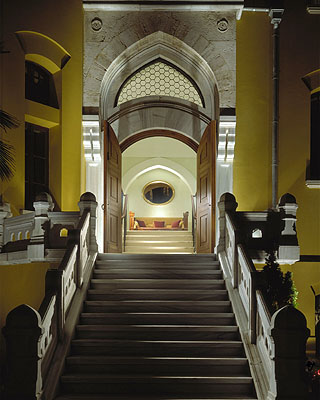 In Istanbul's old town, just around the corner from the
Blue Mosque and Saint Sophia's, is the remarkable Four Seasons Hotel (left; 1 Tevkifhane Sokak;
011-90-212-63- 8200), fashioned from a
century-old Turkish prison, of which little remains but the shell and a
few
windows with bars. If the idea of
staying in such quarters makes you shiver, the prison was, as I
understand it,
reserved for dissidents, not the hard-core criminals, and it appears to
have
been fairly low-key in its deprivations. Today,
however, it is one of the most luxurious and
sophisticated venues
in
In Istanbul's old town, just around the corner from the
Blue Mosque and Saint Sophia's, is the remarkable Four Seasons Hotel (left; 1 Tevkifhane Sokak;
011-90-212-63- 8200), fashioned from a
century-old Turkish prison, of which little remains but the shell and a
few
windows with bars. If the idea of
staying in such quarters makes you shiver, the prison was, as I
understand it,
reserved for dissidents, not the hard-core criminals, and it appears to
have
been fairly low-key in its deprivations. Today,
however, it is one of the most luxurious and
sophisticated venues
in If you do intend to stay on the Asian side of the city--the view alone is worth it--as do many business
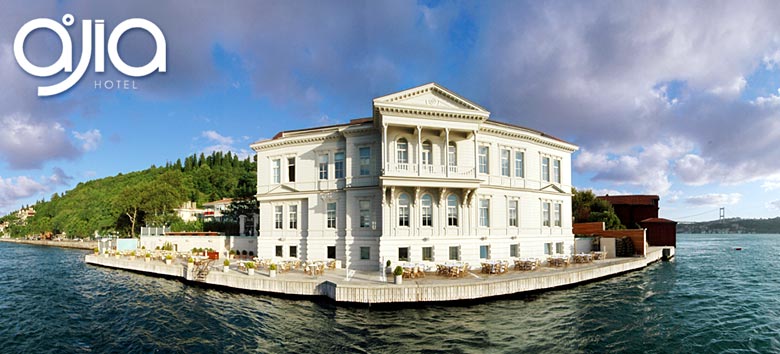 travelers (Coca-Cola has
its headquarters there) the newest and best hotel, opened a little over
a year ago, is the A’Jia
Hotel (27 Çubulku
Caddesi; 011- 90-216-413-9300), on the
site of the former Ahmet Rashim Pasha mansion. Here the room count is
even lower--just 16 rooms--and the decor very modern--all white, with
arched rooms and a glorious view of the Bosporus from a patio where
they serve first-rate Italian cuisine.
travelers (Coca-Cola has
its headquarters there) the newest and best hotel, opened a little over
a year ago, is the A’Jia
Hotel (27 Çubulku
Caddesi; 011- 90-216-413-9300), on the
site of the former Ahmet Rashim Pasha mansion. Here the room count is
even lower--just 16 rooms--and the decor very modern--all white, with
arched rooms and a glorious view of the Bosporus from a patio where
they serve first-rate Italian cuisine.You can reach A'Jia by ferry, which will constitute some of the loveliest five minutes you will spend in Istanbul, especially if the moon is up and the evening prayers are being ululated from the minarets.
Parts Two and Three of this article, on the food and restaurants of Istanbul, will appear in upcoming issues.
by John Mariani
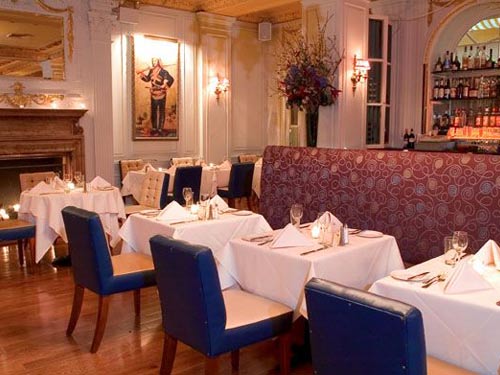 Table
XII
Table
XII109 East 56th Street
212-750-5656
Not a week goes by in New York when at least two or three new Italian restaurants don't open. Usually they are of the trattoria stratum, homey little places with small menus reflective of the owners' personal taste, with prices that hover in between inexpensive and expensive. Few Italian restaurateurs have attempted to change the perception of people who believe Italian food should stick to being yummy and familiar and that Italian restaurants shouldn't cost all that much or try to hard to look good. Of course, an old warhorses like Il Mulino, with prices as high as any French deluxe restaurant in the city, flies in the face of such conventional wisdom, and long-established fine Italian dining rooms like Felidia, San Domenico and L'Impero have achieved a status that puts them in a rank with the best in the city of any stripe. Nevertheless, once in a while, a restaurateur takes a stand to show that Italian restaurants can manifest the same modernity and sophistication as can a French salon. Mario Batali with Joseph and Lidia Bastianich have taken this leap at the new Del Posto, Scott Conant and Chris Cannon have done so at Alto, and Michael Cetrulo has at both Scalini Fedeli and his new Piano Due, with varying degrees of success.
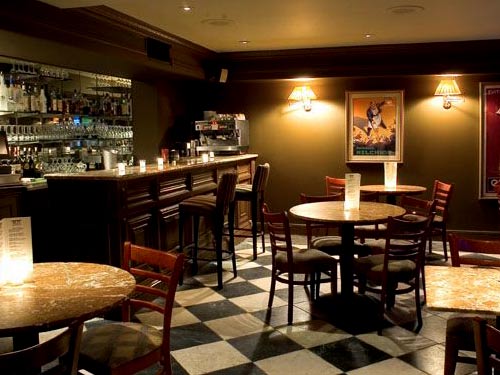
Now comes Table XII, opened by John Scotto (whose family runs Fresco by Scotto), who has taken a very admirable risk in opening a posh Italian restaurant on East 56th Street, a stretch that has never been able to support fine dining in the evening. Indeed, Scotto himself has reconfigured this two-level space twice (formerly The Park and Etoile) adjacent to the Lombardy Hotel and once home to William Randolph Hearst. Those with an elephantine gastronomic memory may recall the premises as once housing Laurent. Now, $3 million has gone into making Table XII a reality, with arched ceilings, finely decorated columns, velvet banquettes, a handsome bar (right) above the 95-seat dining room (above), and cream colors accented with good lighting throughout. True, there is something vaguely hotel dining room-ish about the space, but it's extremely comfortable, and Mr. Scott is always on hand to make sure you are well taken care of.
The first chef here was the peripatetic Sandro Fioriti, who has now moved on, replaced by the young, extremely talented Benedetto "Benny" Bartolotta (seen at right, below, with Scotto), previously at Felidia, then as executive chef at San Domenico under Odette Fada. He has energy and good ideas but he keeps them within the context of classic Italian cooking, from impeccable pastas to well-rendered antipasti.
I had an delicious lunch one day with an editor, followed, on a recent spring evening with three friends, when I sat down to a graciously set, candlelit table with fine linens and good glassware. We were greeted cordially, as is everyone, by Mr. Scotto and his staff. If you like Mr. Bartolotta can prepare a menu for you, which we more or less assented to, and overall it was a very, very lovely evening out.
By all means order antipasti, which constitute some of the best things on the menu, from sautéed calamari with cherry tomatoes, oregano, and a tingle of pepperoncino and Sardinian carasau wafer bread, to wonderful goat's cheese timbale with dried figs, chestnut honey, and crisp pancetta. Plump langoustines came with crusted potatoes, shavings of Parmesan cheese and butternut squash sauce, and I was impressed by a bird's nest of puff pastry with a five-minute cooked egg with wild mushrooms and a lush sauce of Parmigiano. A classic dish of tender tripe came with cannellini beans and assertive pecorino grated over it.
Some early reviews suggested that Table XII's menu was rather conservative, even old-fashioned, though the antipasti just named belie that notion. So, too, do pastas like a generous plate of rigatoni studded with spicy sausage and dressed with a bell pepper sauce, and some fabulous potato ravioli with balsamic vinegar and stracchino cheese. For the adventurous palate, by all means have the fat spaghetti called bucatini lavished with sardines, pine nuts, raisins, tomatoes, dill, and toasted breadcrumbs--one of those "poor man's dishes" of Sicily that becomes ennobled by Bartolotta's bravado. We all fought over a platter of veal ravioli simply glazed with butter and sage, but the most tantalizing dish of all was lemon-flavored spaghetti with lemon zest, lemon juice, and just enough cream to ameliorate the citrusy tang (below).
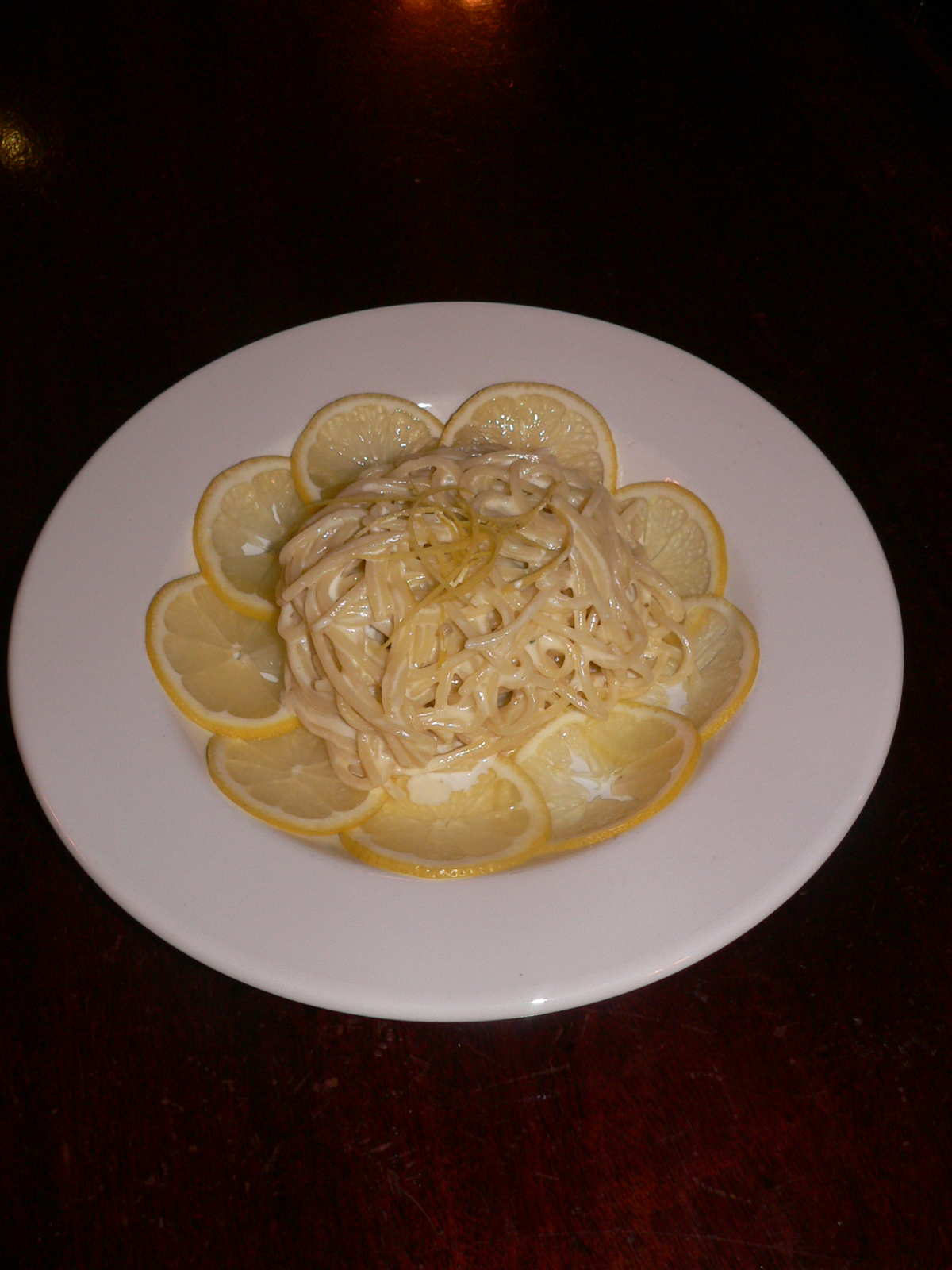 As is often the case in Italian
restaurants in New York, main courses come off as a bit too fussy,
rather than simply as they do in Italy. There was certainly
much to love about grilled shrimp with a puree of chickpeas, sun-dried
tomatoes, olives and rosemary, and a guinea fowl stuffed with mushrooms
and accompanied by grilled asparagus hit the proper note. But
ocean trout dusted with sesame seeds, served with a lentil salad, a
julienne of radicchio and a red wine reduction went a little too far
with disparate flavors, and a pan-seared venison with shallots,
chestnuts, Brussels sprouts, and red wine sauce was far more à la
forestière that alla
boscaiola. Take just one ingredient from his
seared pork chop with a puree of prunes and Jerusalem artichokes, and
thyme-scented Brussels sprouts, and you'd have a better dish. Very good, however, is either the
roasted baby goat scented with juniper berries and served with broccoli
di rabe and blue potatoes.
As is often the case in Italian
restaurants in New York, main courses come off as a bit too fussy,
rather than simply as they do in Italy. There was certainly
much to love about grilled shrimp with a puree of chickpeas, sun-dried
tomatoes, olives and rosemary, and a guinea fowl stuffed with mushrooms
and accompanied by grilled asparagus hit the proper note. But
ocean trout dusted with sesame seeds, served with a lentil salad, a
julienne of radicchio and a red wine reduction went a little too far
with disparate flavors, and a pan-seared venison with shallots,
chestnuts, Brussels sprouts, and red wine sauce was far more à la
forestière that alla
boscaiola. Take just one ingredient from his
seared pork chop with a puree of prunes and Jerusalem artichokes, and
thyme-scented Brussels sprouts, and you'd have a better dish. Very good, however, is either the
roasted baby goat scented with juniper berries and served with broccoli
di rabe and blue potatoes.Desserts are first rate, from a ricotta-rich cannoli with chocolate shavings to a chocolate soufflé with amaretto ice cream and raspberry sauce.
The winelist at Table XII is remarkable for its breadth and depth, including just about any fine Italian wine you can think of along with some very rare California cult wines you're unlikely to find around town in more than two or three other restaurants. Prices are fair-minded too.
I am very happy that Mr. Scotto has taken the leap without pushing his prices into the stratosphere: Dinner appetizers run $9-$18, pastas (full portions) are $14-$18, and main courses top out at $35. All of which mean you could feast on four courses--antipasti, pasta, main course, and dessert--and still be out for about $60. Since all is à la carte, you can do it for considerably less and feel like you've dined with real gusto.
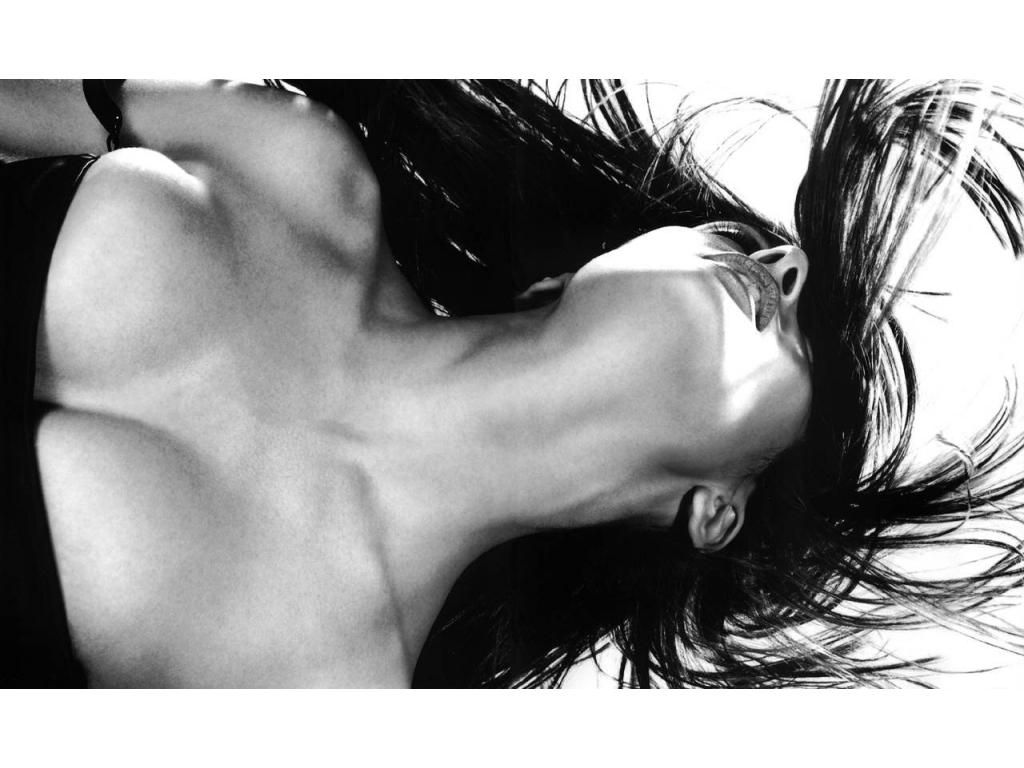 WE
KNOW RIGHT WHERE THE BUNS WENT
WE
KNOW RIGHT WHERE THE BUNS WENTFIRST, OPEN CAN, THEN REMOVE CHILIES

DEPARTMENT OF CORRECTIONS
"THE SWEET LIFE" CRUISE
 This fall, from Sept. 29-Oct. 6 John Mariani (left),
publisher of Mariani's Virtual
Gourmet and food & travel columnist for Esquire Magazine, will host
and lead a 7-day cruise called "The Sweet Life," aboard
Silverseas' Millennium Class Silver
Whisper,
with days visiting Barcelona, Tunis, Naples, Milazzo (Sicily), Rome,
Livorno, and Villefranche. There will be a welcoming cocktail
party,
gourmet dinners with wines, cooking demos by John and Galina Mariani
co-authors of The Italian-American
Cookbook),
This fall, from Sept. 29-Oct. 6 John Mariani (left),
publisher of Mariani's Virtual
Gourmet and food & travel columnist for Esquire Magazine, will host
and lead a 7-day cruise called "The Sweet Life," aboard
Silverseas' Millennium Class Silver
Whisper,
with days visiting Barcelona, Tunis, Naples, Milazzo (Sicily), Rome,
Livorno, and Villefranche. There will be a welcoming cocktail
party,
gourmet dinners with wines, cooking demos by John and Galina Mariani
co-authors of The Italian-American
Cookbook),  optional shore excursions will include a
tour of the Amalfi Coast,
dinner at the great Don Alfonso 1890 (2 Michelin stars), a private tour
of the Vatican, dinner at La Pergola (3 Michelin stars) in Rome, a
Night Cruise to Hotel de Paris and dinner at Louis XV (3 Michelin
stars)
in Monaco, and much more. Rates (a 20% savings) range from $4,411
to
$5,771. For complete information click.
optional shore excursions will include a
tour of the Amalfi Coast,
dinner at the great Don Alfonso 1890 (2 Michelin stars), a private tour
of the Vatican, dinner at La Pergola (3 Michelin stars) in Rome, a
Night Cruise to Hotel de Paris and dinner at Louis XV (3 Michelin
stars)
in Monaco, and much more. Rates (a 20% savings) range from $4,411
to
$5,771. For complete information click.QUICK BYTES
To all media publicity agents: Owing to the large volume of announcements received regarding holiday events, I will only have room in this newsletter for those that have a unique distinction to them. It would be impossible to list all Passosver and Easter dinners unless they are part of a larger, more extensive format.--John Mariani
* From April 27 – May 21 Napa Rose in Anaheim, CA, will hosting nationally acclaimed guest chefs on Thurs. nights leading into each weekend: April 27 – Chef Michael Cimarusti, Providence (LA); May 4 – Chef Carl Schroder, Arterra (San Diego); May 11 – Chef James Boyce, Studio at the Montage Resort (Laguna Beach); May 18 – Chef Michael White, Fiamma (NYC and Las Vegas). This 1st annual event will also feature wine, beer and spirit seminars, culinary demos, guest sommelier seminars at both Disney’s California Adventure and the Disneyland Resort Hotels, in addition to ‘Cooking School’ at Napa Rose. Visit http://www.disneygallery.com/. . . . Additionally, The Little Nell’s Ryan Hardy will be guest chef at a fundraiser event at Napa Rose on April 20.
~~~~~~~~~~~~~~~~~~~~~
Istanbul: Caviar, Saint Sophia, Basilica Cistern, Grand Bazaar, Spice Market, Ciragn Hotel--Galina Stepanoff-Dargery; Yargici--courtesy of Yargici; Four Seasons Hotel--courtesy of Four Seasons Hotels; A'jia Hotel--courtesy of A'Jia Hotel; Table XII: All photos courtesy of Table XII..
~~~~~~~~~~~~~~~~~~~~~~~~~~~~~~~~~~~~~~~~~~~~~~~~~~~~~~~~~~~~~~~~~~~~~~~~~
MARIANI'S VIRTUAL GOURMET NEWSLETTER is published weekly. Editor/Publisher:
John Mariani. Contributing Writers: Robert Mariani, Naomi
Kooker, Kirsten Skogerson, Edward Brivio, Mort
Hochstein, Suzanne Wright. Contributing
Photographers: Galina Stepanoff-Dargery, Bobby Pirillo. Technical
Advisor: Gerry McLoughlin.
Any of John Mariani's books below
may be ordered from amazon.com by clicking on the cover image.
 |
 |
 |
 |
 |
 |
copyright John Mariani 2006